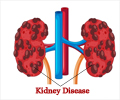Exposure to environmental toxins such as arsenic, cadmium, chromium, early in life via contaminated water can have long-term health consequences in children.

‘KIM-1 may be an early warning sign of exposure, suggesting that something may be beginning to go wrong in the epithelial cells in the kidneys of these children.’





Investigators at Brigham and Women's Hospital and the Harvard Program in Therapeutic Sciences at Harvard Medical School have assessed level of toxins in children living in a region of Mexico. Not only did the team detect high levels of the arsenic and chromium in urine samples from the children, they also were able to detect elevated levels of KIM-1, a biomarker that is being studied as an early sign of kidney injury. The team's findings are published in Environmental Research. "Until now, no one has studied these children - an especially vulnerable population - to determine their risk of exposure and possible measures of kidney dysfunction," said senior author Vishal Vaidya, PhD, a principal investigator at Brigham and Women's Hospital, Harvard Medical School and Harvard T.H. Chan School of Public Health. "KIM-1 may be an early warning sign of exposure, suggesting that something may be beginning to go wrong in the epithelial cells in the kidneys of these children. Many questions remain to be answered: we don't know if this effect might be reversible, we don't know if there are other kidney toxic contaminants such as uranium present as well. Because we don't have follow-up data from these children we also don't know the long-term consequences of this exposure. But this does give us our first insights into this population at a young age."
The team found exceedingly high levels of arsenic and chromium in urine samples collected from 107 children living in the north-central region of Mexico - levels that were even higher than exposure limits set for adults. When the team measured traditional biomarkers of kidney function - such as those measured at a routine physical exam - they did not find elevated levels of these markers.
However, more sensitive and specific biomarkers of kidney injury recently qualified by the FDA for use in preclinical studies, including Kidney Injury Molecule-1 (KIM-1), were elevated in the children. (KIM-1 was first discovered by paper co-author Joseph Bonventre, MD, PhD, chief of the Renal Unit and director of the Bioengineering Division at BWH.)
"For the first time, we've been able to evaluate and assess an early warning sign of kidney injury - one that may give us the ability to act in advance before there is irreversible harm," said first author Mariana Cardenas-Gonzalez, PhD, a postdoctoral fellow in the Vaidya lab. "This may be a problem that can be solved by reducing exposure, but first we need to understand how such high levels of these toxins are winding up in the urine of these children."
Advertisement
In addition to the unknown route of exposure, other questions remain to be answered about the short-term and long-term consequences of elevated levels of these toxins in children and whether reducing exposure may reduce risk of injury. Cardenas-Gonzalez, who is currently in the process of accepting a role as a principal investigator at a university in Mexico that will begin this fall, plans to return to Villa de Reyes county in San Luis Potosi, Mexico to continue to follow the children over time.
Advertisement
Source-Eurekalert















